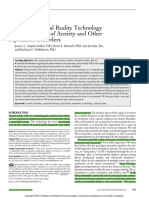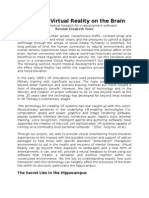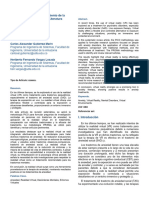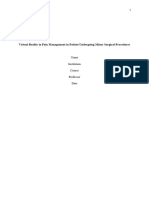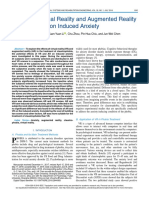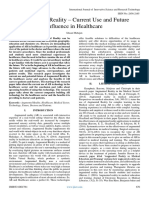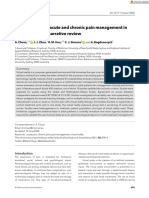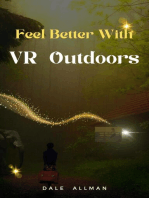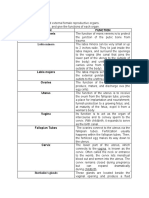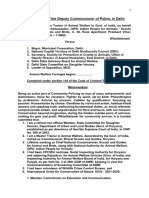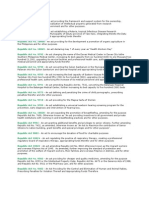Professional Documents
Culture Documents
The Use of Interventions Based On Virtual Reality in The Treatment of Anxiety
Original Title
Copyright
Available Formats
Share this document
Did you find this document useful?
Is this content inappropriate?
Report this DocumentCopyright:
Available Formats
The Use of Interventions Based On Virtual Reality in The Treatment of Anxiety
Copyright:
Available Formats
Volume 8, Issue 1, January – 2023 International Journal of Innovative Science and Research Technology
ISSN No:-2456-2165
The Use of Interventions Based on Virtual
Reality in the Treatment of Anxiety
Ramagiri Nivas Komuravelli Vasanth
Department Computer Science and Engineering, Department Computer Science and Engineering,
Chandigarh University. Punjab, India Chandigarh University. Punjab, India
Sheikh Owais Aaman
Department of Computer Science and Engineering,
SRM Institute of Science and Technology. Chennai, India
Abstract:- With the development of virtual reality (VR) referral, may benefit from the accessibility offered by virtual
technology has come the advent of virtual reality (VR) reality therapy. This can encourage them to seek help from a
therapy for anxiety disorders. Because it is more effective professional. The purpose of this special issue was to get an
than waitlist therapy and has an efficacy that is understanding of the benefits and limitations of VR treatment
comparable to that of in vivo exposure therapy, virtual in terms of alleviating the symptoms of anxiety. Anxiety is
reality therapy can be considered a viable psychological caused by the perception of an impending danger (Penninx et
intervention. Those individuals who are less likely to al., 2021; Hamm, 2020). Anxiety is defined as "muscle
participate in face-to-face therapy, as well as those with tension and attention in preparation for potential danger and
mild-to-moderate and/or subclinical levels of anxiety who careful avoidance behaviour," and both of these
may not reach the threshold for clinical referral, may characteristics are seen in anxious people (American
benefit from the accessibility offered by virtual reality Psychiatric Association, 2013). Anxiety consists of both a
therapy. This can encourage them to seek help from a mental component, such as the dread that the worst-case
professional. The purpose of this special issue was to gain scenario may occur, and a physiological component, such as
an understanding of the benefits and limitations of VR heightened arousal, perspiration, and the sense that one could
therapy in terms of alleviating the symptoms of anxiety. pass out (Creamer et al., 1995). The following are some of the
Anxiety is caused by the perception of an impending questions that were intended to be answered by this special
danger. The symptoms of anxiety include "muscle tension issue:
and vigilance in preparation for future danger and In terms of theory, virtual reality treatment has been
cautious avoidance behaviour". Anxiety can also manifest shown to be effective for both severe and mild cases of
as a physical sensation in the body. Anxiety consists of anxiety.
both a mental component, such as the fear that the worst- The effectiveness of virtual reality treatment in alleviating
case scenario will occur, and a physiological component, stress,
such as increased arousal, sweating, and the feeling that The mechanisms of responsiveness to virtual reality
one might pass out. Understanding the theoretical treatment for anxiety reduction, and
significance of virtual reality therapy for clinical and sub- The technical boundaries of VR treatment.
clinical levels of anxiety, the efficacy of virtual reality
therapy for reducing anxiety, the mechanisms of response II. THEORETICAL FOUNDATIONS FOR THE
to virtual reality therapy for reducing anxiety, and the PRACTICE OF VIRTUAL-REALITY
technological limits of VR therapy were the goals of this THERAPY IN THE TREATMENT OF
special issue. ANXIETY
Keywords:- Attention Training, Presence, Cybersickness, The "wow" element of the technology may encourage
Relaxation, Pain. individuals to construct virtual worlds for therapeutic
applications in a way that is not contextualised, hence it is
I. INTRODUCTION imperative that research on virtual reality for anxiety
disorders be led by theory. An early randomised clinical trial
With the development of virtual reality (VR) technology used virtual reality for the treatment of a fear of heights
has come the introduction of virtual reality (VR) treatment for (Rothbaum et al., 1995). This trial relied on emotional
anxiety disorders. The fact that its effectiveness is greater to processing theory (Foa and Kozak, 1986), which suggests that
that of a waitlist and similar to that of in vivo exposure exposure therapy modulates a dysfunctional fear structure
therapy (Carl et al., 2019) makes virtual reality therapy a and provides information that is incompatible with the fear-
feasible option for psychiatric treatment. Those individuals associated memory. In this issue, Jerath and Beveridge rely
who are less likely to participate in face-to-face therapy, as on theories of the philosophy of mind and theories of global
well as those with mild-to-moderate and/or subclinical levels and spatial cognition to inspire future research on how virtual
of anxiety who may not reach the threshold for clinical reality might reduce anxiety through the development of
IJISRT23JAN370 www.ijisrt.com 126
Volume 8, Issue 1, January – 2023 International Journal of Innovative Science and Research Technology
ISSN No:-2456-2165
enormous virtual landscapes, such as gazing up at a bright sky important components of VR exposure treatment is paying
at night. The authors argue that anxiety is characterised by attention to a virtual core danger.
vicious loops that may be broken by transcendent experiences
produced in wide virtual settings, such as the universe, Additionally, there are physiological factors that might
employing slow deep breathing and biofeedback. [Citation change how one reacts to anxiety. In a virtual reality (VR)-
needed] [Citation needed] Exciting new avenues for research based relaxation training programme, Joeng et al.
into the advantages of transcending virtual experiences may investigated the effects that practising diaphragmatic
be opened up if virtual reality technology were to advance to breathing (DB, increasing breathing volume and allowing
the point where it could generate enormous areas using more air to the body) and progressive muscle relaxation
testable assumptions. (PMR, sequentially alternating muscle tension and
relaxation) exercises had on participants. When compared to
III. VIRTUAL-REALITY THERAPY'S EFFICACY a control group, individuals who trained in VR had
significantly reduced levels of stress following PMR. In the
In the absence of a therapist, VR technology shows VR group, DB was shown to reduce stress, especially when
potential for self-guided VR treatment in which the user has the participants were practising in potentially anxious virtual
complete control over increasing their exposure to danger outdoor surroundings. DB has a primary effect of enhancing
(Zainal et al., 2021; Premkumar et al.). Over two sessions of the parasympathetic response, in addition to enhancing
self-guided VR treatment, participants with significant self- sustained concentration and reducing negative emotion (Ma
reported public-speaking anxiety increased their exposure to et al., 2017). Therefore, the use of physiological procedures
changeable virtual hazards (Premkumar et al.). This as well as training aspects to promote extra coping
exploratory study's findings of persistent improvement in mechanisms might be beneficial to VR-based anxiety
public-speaking anxiety and social anxiety 1 month after the exposure treatments.
intervention show the long-term effects of self-guided VR
treatment. Where persistent physical sickness, such as cancer, V. TECHNOLOGICAL BASES FOR VIRTUAL-
causes anxiety, VR treatment may create pleasant virtual REALITY THERAPY
settings. According to MIND (2021), "spending time in green
space or incorporating nature into your daily life may help Cybersickness, such as dizziness and motion sickness,
both your mental and physical welfare" (Naor and Mayseless, has an impact on VR therapeutic participation and
2021). Wilson and Scorsone investigated the advantages of experience. Controlling for cybersickness in VR treatment
bringing patients closer to nature via immersive VR research is essential, and this necessitates the use of a
treatment, as well as creating happy emotions and lowering validated measure of cybersickness that separates
pain levels, in this context. Participants getting intravenous cybersickness from the target psychological symptoms of the
chemotherapy felt more peaceful, relaxed, and satisfied, as planned intervention. Bouchard et al. discovered that anxiety
well as less tense, after choosing from a broad choice of during stress exposure (the Trier Social Stress Test, study 2)
nature-inspired immersive audio-visual experiences to was confounded by cybersickness in addition to verifying the
encourage relaxation during treatment. This anxiety-reducing two-factor structure of the simulation-sickness questionnaire
effect of VR therapy during physical condition treatment is (SSQ, study 1). They discovered that the majority of SSQ
also true for other associated disorders, such as stroke items (11 out of 16) linked with state anxiety following stress
rehabilitation (Standen et al., 2017). exposure, and that these relationships were distributed
equally among the two SSQ variables. The SSQ score rose
IV. THE WORKINGS OF THE VIRTUAL- after stress exposure and before immersion in a virtual world.
REALITY THERAPY MECHANISM Thus, during the administration of VR treatment,
cybersickness may be misinterpreted with anxiety, and such
There is a pressing need to acquire a deeper and more symptoms must be accounted for when evaluating the
comprehensive understanding of the processes of anxiety effectiveness of VR therapy.
reduction that are applicable to VR therapy. Pfaller et al.
focused their attention on the function that social presence This special issue has highlighted the possibility for
plays in triggering emotional reactions during certain agent potentially significant VR therapeutic advances. The
social interactions in order to achieve this goal. As a result, potential for revolutionary VR treatments to merge virtual
changing one's social presence might result in therapies that wide open spaces, self-guided exposure and relaxation, while
are more successful in increasing one's ability to engage with improving social presence via attention training and resolving
others. Another method that virtual reality treatment uses is cybersickness, illustrates virtual reality's great potential.
attention training, which helps patients acquire control over
worried thoughts and feelings. Participants with high levels
of public speaking anxiety were used in an experiment by
Wechsler and colleagues to investigate the impact of training
with an external focus on attention. When participants were VI. CONCLUSION
trained to pay attention to members of the audience in a
virtual setting, the amount of time they spent gazing at the Twenty years have passed since the first research paper
virtual audience during a public speech after the training rose, on the use of virtual reality to treat a psychological disorder
as did their positive affect. As a result, one of the most was published in 199510, and here we are. Virtual reality has
IJISRT23JAN370 www.ijisrt.com 127
Volume 8, Issue 1, January – 2023 International Journal of Innovative Science and Research Technology
ISSN No:-2456-2165
emerged as a practical tool that can assist in the treatment of
a variety of disorders. The use of virtual reality has been
shown to be most effective in the treatment of patients
undergoing exposure therapy for anxiety disorders, cue
exposure therapy for patients undergoing treatment for
substance use disorders, and distraction for patients
undergoing treatment for acute pain that requires painful
procedures. In general, meta-analyses have shown that virtual
reality (VR) is a useful tool, that it performs well when
compared to control conditions, and that it has long-lasting
effects that are transferable to the real world. However, there
are some issues that have been brought to light, such as the
lack of comparison groups, the lack of methodological rigour,
and the small sample sizes. It is likely that the number of
virtual reality applications will increase in the near future as
the price of head-mounted displays continues to drop and
smaller applications for smart phones continue to be
developed. It will be essential that these be regarded as tools,
and that therapists receive adequate training in the appropriate
uses of these tools.
REFERENCES
[1]. American Psychiatric Association (2013). Diagnostic
and Statistical Manual of Mental Disorders: DSM-5.
Arlington, VA, US: American Psychiatric Publishing,
Inc.
[2]. Carl, E., Stein, A. T., Levihn-Coon, A., Pogue, J. R.,
Rothbaum, B., Emmelkamp, P., et al. (2019). Virtual
Reality Exposure Therapy for Anxiety and Related
Disorders: A Meta-Analysis of Randomized Controlled
Trials. J. Anxiety Disord. 61, 27–36.
doi:10.1016/j.janxdis.2018.08.003
[3]. Creamer, M., Foran, J., and Bell, R. (1995). The Beck
Anxiety Inventory in a Nonclinical Sample. Behav. Res.
Ther. 33, 477–485. doi:10.1016/0005-7967(94) 00082-
U Foa, E. B., and Kozak, M. J. (1986). Emotional
Processing of Fear: Exposure to Corrective Information.
Psychol. Bull. 99, 20–35. doi:10.1037/0033-2909.99.
1.20
[4]. Hamm, A. O. (2020). Fear, Anxiety, and Their
Disorders from the Perspective of Psychophysiology.
Psychophysiology 57, e13474. doi:10. 1111/psyp.13474
[5]. Ma, X., Yue, Z.-Q., Gong, Z.-Q., Zhang, H., Duan, N.-
Y., Shi, Y.-T., et al. (2017).
[6]. The Effect of Diaphragmatic Breathing on Attention,
Negative Affect and Stress in Healthy Adults. Front.
Psychol. 8, 874. doi:10.3389/fpsyg.2017.00874
[7]. MIND (2021). How Can Nature Benefifit My Mental
Health? Stratford, London, United Kingdom: MIND.
[8]. Naor, L., and Mayseless, O. (2021). Therapeutic Factors
in Nature-Based Therapies: Unraveling the Therapeutic
Benefifits of Integrating Nature in Psychotherapy.
Psychotherapy 58, 576–590. doi:10.1037/ pst0000396
[9]. Penninx, B. W., Pine, D. S., Holmes, E. A., and Reif, A.
(2021). Anxiety Disorders.
[10]. The Lancet 397, 914–927. doi:10.1016/S0140-
6736(21)00359-7
IJISRT23JAN370 www.ijisrt.com 128
You might also like
- QUIZ 3 Disaster Readiness and Risk ReductionDocument5 pagesQUIZ 3 Disaster Readiness and Risk ReductionRain Gamboa100% (1)
- Unit IG2: Risk AssessmentDocument22 pagesUnit IG2: Risk Assessmentprijith j100% (6)
- The Use of Virtual Reality Technology in The Treatment of Anxiety and Other Psychiatric Disorders PDFDocument11 pagesThe Use of Virtual Reality Technology in The Treatment of Anxiety and Other Psychiatric Disorders PDFandiNo ratings yet
- Sex Trafficking in EuropeDocument5 pagesSex Trafficking in EuropeimpunitywatchNo ratings yet
- Australian/New Zealand StandardDocument53 pagesAustralian/New Zealand Standardhitman1363100% (1)
- Solution Manual For Health Psychology 11th Edition Shelley Taylor Annette L StantonDocument7 pagesSolution Manual For Health Psychology 11th Edition Shelley Taylor Annette L StantonJamesThomasngec100% (45)
- A Qualitative Study On Stressors Stress Symptoms and Coping Mechanisms Among High School Students PASCALDocument47 pagesA Qualitative Study On Stressors Stress Symptoms and Coping Mechanisms Among High School Students PASCALASh tabaog0% (1)
- ContentServer AspDocument12 pagesContentServer AspandreasnchzrojoNo ratings yet
- Krijn 2004 - Virtual Reality Exposure of Anxiety Disorders PDFDocument23 pagesKrijn 2004 - Virtual Reality Exposure of Anxiety Disorders PDFJane DoeNo ratings yet
- 1 s2.0 S2352250X21000142 MainDocument6 pages1 s2.0 S2352250X21000142 MainflaviasmansanoNo ratings yet
- Virtual Reality in The Assessment, Understanding, and Treatment of Mental Health DisordersDocument8 pagesVirtual Reality in The Assessment, Understanding, and Treatment of Mental Health DisordersDiana IchimNo ratings yet
- Freeman, 2017 Overview VRDocument8 pagesFreeman, 2017 Overview VRmatalacurNo ratings yet
- Iee Adib Tech SeminarDocument5 pagesIee Adib Tech SeminarAdib AhamedNo ratings yet
- Design Strategies For Virtual Reality Interventions For Managing Pain and Anxiety in Children and Adolescents: Scoping ReviewDocument11 pagesDesign Strategies For Virtual Reality Interventions For Managing Pain and Anxiety in Children and Adolescents: Scoping ReviewTheofilioNo ratings yet
- Virtual Reality Therapy for PhobiasDocument2 pagesVirtual Reality Therapy for PhobiasLudor EngineeringNo ratings yet
- Tratamiento de Transtornos de Ansiedad Con Terapia de Exposición A Realidad VirtualDocument4 pagesTratamiento de Transtornos de Ansiedad Con Terapia de Exposición A Realidad VirtualOmar AlvarezNo ratings yet
- Virtual Reality Article PublishedDocument16 pagesVirtual Reality Article PublishedSonia RodriiguezNo ratings yet
- Benefits of Virtual RealityDocument11 pagesBenefits of Virtual RealityBethNo ratings yet
- The Challenges and Perspectives of The Integration Between Virtual and Augmented Reality and Manual TherapiesDocument18 pagesThe Challenges and Perspectives of The Integration Between Virtual and Augmented Reality and Manual Therapiesradhianie djanNo ratings yet
- 1 s2.0 S2215036618302621 MainDocument2 pages1 s2.0 S2215036618302621 Mainstevenburrow06No ratings yet
- Virtual Reality Exposure TherapyDocument3 pagesVirtual Reality Exposure TherapyAarushi RohillaNo ratings yet
- Despre Agora Si VRDocument10 pagesDespre Agora Si VRcora4eva5699No ratings yet
- Clinical Epidemiology and Global Health: Mohd Javaid, Abid HaleemDocument6 pagesClinical Epidemiology and Global Health: Mohd Javaid, Abid HaleemFelipe RuizNo ratings yet
- Virtualreal Psychotherapeutic ToolDocument29 pagesVirtualreal Psychotherapeutic Toollic.evelincincottaNo ratings yet
- Virtual Reality-Enhanced Extinction of Phobias and Post-Traumatic StressDocument10 pagesVirtual Reality-Enhanced Extinction of Phobias and Post-Traumatic StressDiana IchimNo ratings yet
- Wieder Hold 2019Document4 pagesWieder Hold 2019Kaneki KenNo ratings yet
- AppliedVR White Paper 191105Document3 pagesAppliedVR White Paper 191105ElenaNo ratings yet
- Journal Pone 0287984Document15 pagesJournal Pone 0287984RANUM WANUDYA YUNASNo ratings yet
- CrysralDocument30 pagesCrysralAdib AhamedNo ratings yet
- Virtualreality Brainfunction WebuploadDocument5 pagesVirtualreality Brainfunction Webuploadapi-287153107No ratings yet
- Emmelkamp, P. M. G., Meyerbröker, K., & Morina, N. (2020) - Virtual Reality Therapy in Social Anxiety Disorder. in Current Psychiatry ReportsDocument9 pagesEmmelkamp, P. M. G., Meyerbröker, K., & Morina, N. (2020) - Virtual Reality Therapy in Social Anxiety Disorder. in Current Psychiatry Reportsusing shodanNo ratings yet
- Tercera Entrega Carlos Alexander Gutierrez MarinDocument8 pagesTercera Entrega Carlos Alexander Gutierrez Marinkillermariin99No ratings yet
- Role of Virtual Reality in Neurological Rehabilitation: Dr. Nidhi Sharma (PT)Document19 pagesRole of Virtual Reality in Neurological Rehabilitation: Dr. Nidhi Sharma (PT)Nidhi SharmaNo ratings yet
- Texto 1 RDocument7 pagesTexto 1 ROmid Ernesto Chahuaris ChoqueNo ratings yet
- NeuAR A Review of The VR AR ApplicationsDocument24 pagesNeuAR A Review of The VR AR ApplicationsYishuai ZhangNo ratings yet
- 10.1007@s11920 020 01156 1Document9 pages10.1007@s11920 020 01156 1Evelyn Melani Vargas BenavidesNo ratings yet
- Seminar ReportDocument30 pagesSeminar ReportKhadeeja AshnaNo ratings yet
- The Applications of Virtual Reality Technology in Medical Groups TeachingDocument10 pagesThe Applications of Virtual Reality Technology in Medical Groups TeachingOmid Ernesto Chahuaris ChoqueNo ratings yet
- Virtual Reality in Pain ManagementDocument7 pagesVirtual Reality in Pain Managementjennylovex4realNo ratings yet
- The Virtual Meditative Walk: Virtual Reality Therapy For Chronic Pain ManagementDocument5 pagesThe Virtual Meditative Walk: Virtual Reality Therapy For Chronic Pain ManagementMiquel Porcel BareaNo ratings yet
- A Systematic Review of The Effectiveness of Virtual Reality-Based InterventionsDocument14 pagesA Systematic Review of The Effectiveness of Virtual Reality-Based InterventionsAlecxis De LaraNo ratings yet
- Priyanka ProjectDocument30 pagesPriyanka ProjectPriyanka ValluriNo ratings yet
- The Role of Virtual and Augmented Reality in Ortho - 2020 - Computer Methods andDocument11 pagesThe Role of Virtual and Augmented Reality in Ortho - 2020 - Computer Methods andAndres ChiribogaNo ratings yet
- AnsiedadDocument20 pagesAnsiedadMontserrat RubiNo ratings yet
- Atde 16 Atde210131Document10 pagesAtde 16 Atde210131Josip StjepandicNo ratings yet
- Implementations of Virtual Reality For Anxiety-Related Disorders: Systematic ReviewDocument14 pagesImplementations of Virtual Reality For Anxiety-Related Disorders: Systematic ReviewNico AlaluNo ratings yet
- Sept VJC PaperDocument4 pagesSept VJC PaperLuis Guillermo Wong JaraNo ratings yet
- Computer AssignmentDocument6 pagesComputer AssignmentElsa malikNo ratings yet
- Virtual Reality in The Rehabilitation of CognitiveDocument13 pagesVirtual Reality in The Rehabilitation of CognitiveAnonymous HUY0yRexYfNo ratings yet
- Current Limitations Into The Application of Virtual Reality To Mental Health ResearchDocument4 pagesCurrent Limitations Into The Application of Virtual Reality To Mental Health Researchclyde.machado3225No ratings yet
- IJCRT2109397Document4 pagesIJCRT2109397arvind TttNo ratings yet
- VR Distraccion Control Dolor IsquemicoDocument5 pagesVR Distraccion Control Dolor IsquemicoJuan Manuel Rodriguez JiménezNo ratings yet
- Physiological_measures_and_self_report_to_evaluate_neutral_virtual_reality_worlds_preliminaryDocument19 pagesPhysiological_measures_and_self_report_to_evaluate_neutral_virtual_reality_worlds_preliminarytimothy.dchrist18No ratings yet
- Effects of Virtual Reality and Augmented Reality On Induced AnxietyDocument8 pagesEffects of Virtual Reality and Augmented Reality On Induced AnxietyVanessaNo ratings yet
- Ni Hms 829162Document19 pagesNi Hms 829162Muhamad Rijal TaufiqNo ratings yet
- 2016 - Utilizing Virtual and Augmented Reality For Educational and Clinical Enhancements in NeurosurgeryDocument4 pages2016 - Utilizing Virtual and Augmented Reality For Educational and Clinical Enhancements in NeurosurgeryTejesh PatelNo ratings yet
- Virtual Reality As A Promising Tool For Autism InterventionDocument7 pagesVirtual Reality As A Promising Tool For Autism InterventionEditor IJTSRDNo ratings yet
- VR REHABILITATION OF STROKE SURVIVORSDocument10 pagesVR REHABILITATION OF STROKE SURVIVORSHajaros RegraguiNo ratings yet
- Augmented Reality - Current Use and Future Influence in HealthcareDocument6 pagesAugmented Reality - Current Use and Future Influence in HealthcareInternational Journal of Innovative Science and Research TechnologyNo ratings yet
- Anaesthesia - 2020 - Chuan - Virtual Reality For Acute and Chronic Pain Management in Adult Patients A Narrative ReviewDocument10 pagesAnaesthesia - 2020 - Chuan - Virtual Reality For Acute and Chronic Pain Management in Adult Patients A Narrative ReviewBhavika LargotraNo ratings yet
- S1352465813000088Document5 pagesS1352465813000088Kate PhamNo ratings yet
- 2022 10 06 22280777v2 FullDocument35 pages2022 10 06 22280777v2 Fulljulia484838No ratings yet
- Neuroscience of Virtual Reality: From Virtual Exposure To Embodied MedicineDocument16 pagesNeuroscience of Virtual Reality: From Virtual Exposure To Embodied Medicineandre sukimanNo ratings yet
- Paper About Adaptive Virtual RealityDocument4 pagesPaper About Adaptive Virtual RealityArunNo ratings yet
- Diabetic Retinopathy Stage Detection Using CNN and Inception V3Document9 pagesDiabetic Retinopathy Stage Detection Using CNN and Inception V3International Journal of Innovative Science and Research TechnologyNo ratings yet
- Exploring the Molecular Docking Interactions between the Polyherbal Formulation Ibadhychooranam and Human Aldose Reductase Enzyme as a Novel Approach for Investigating its Potential Efficacy in Management of CataractDocument7 pagesExploring the Molecular Docking Interactions between the Polyherbal Formulation Ibadhychooranam and Human Aldose Reductase Enzyme as a Novel Approach for Investigating its Potential Efficacy in Management of CataractInternational Journal of Innovative Science and Research TechnologyNo ratings yet
- Investigating Factors Influencing Employee Absenteeism: A Case Study of Secondary Schools in MuscatDocument16 pagesInvestigating Factors Influencing Employee Absenteeism: A Case Study of Secondary Schools in MuscatInternational Journal of Innovative Science and Research TechnologyNo ratings yet
- An Analysis on Mental Health Issues among IndividualsDocument6 pagesAn Analysis on Mental Health Issues among IndividualsInternational Journal of Innovative Science and Research TechnologyNo ratings yet
- Harnessing Open Innovation for Translating Global Languages into Indian LanuagesDocument7 pagesHarnessing Open Innovation for Translating Global Languages into Indian LanuagesInternational Journal of Innovative Science and Research TechnologyNo ratings yet
- The Utilization of Date Palm (Phoenix dactylifera) Leaf Fiber as a Main Component in Making an Improvised Water FilterDocument11 pagesThe Utilization of Date Palm (Phoenix dactylifera) Leaf Fiber as a Main Component in Making an Improvised Water FilterInternational Journal of Innovative Science and Research TechnologyNo ratings yet
- Advancing Healthcare Predictions: Harnessing Machine Learning for Accurate Health Index PrognosisDocument8 pagesAdvancing Healthcare Predictions: Harnessing Machine Learning for Accurate Health Index PrognosisInternational Journal of Innovative Science and Research TechnologyNo ratings yet
- The Relationship between Teacher Reflective Practice and Students Engagement in the Public Elementary SchoolDocument31 pagesThe Relationship between Teacher Reflective Practice and Students Engagement in the Public Elementary SchoolInternational Journal of Innovative Science and Research TechnologyNo ratings yet
- The Making of Object Recognition Eyeglasses for the Visually Impaired using Image AIDocument6 pagesThe Making of Object Recognition Eyeglasses for the Visually Impaired using Image AIInternational Journal of Innovative Science and Research TechnologyNo ratings yet
- Design, Development and Evaluation of Methi-Shikakai Herbal ShampooDocument8 pagesDesign, Development and Evaluation of Methi-Shikakai Herbal ShampooInternational Journal of Innovative Science and Research Technology100% (3)
- Dense Wavelength Division Multiplexing (DWDM) in IT Networks: A Leap Beyond Synchronous Digital Hierarchy (SDH)Document2 pagesDense Wavelength Division Multiplexing (DWDM) in IT Networks: A Leap Beyond Synchronous Digital Hierarchy (SDH)International Journal of Innovative Science and Research TechnologyNo ratings yet
- Terracing as an Old-Style Scheme of Soil Water Preservation in Djingliya-Mandara Mountains- CameroonDocument14 pagesTerracing as an Old-Style Scheme of Soil Water Preservation in Djingliya-Mandara Mountains- CameroonInternational Journal of Innovative Science and Research TechnologyNo ratings yet
- The Impact of Digital Marketing Dimensions on Customer SatisfactionDocument6 pagesThe Impact of Digital Marketing Dimensions on Customer SatisfactionInternational Journal of Innovative Science and Research TechnologyNo ratings yet
- Formulation and Evaluation of Poly Herbal Body ScrubDocument6 pagesFormulation and Evaluation of Poly Herbal Body ScrubInternational Journal of Innovative Science and Research TechnologyNo ratings yet
- Electro-Optics Properties of Intact Cocoa Beans based on Near Infrared TechnologyDocument7 pagesElectro-Optics Properties of Intact Cocoa Beans based on Near Infrared TechnologyInternational Journal of Innovative Science and Research TechnologyNo ratings yet
- Comparatively Design and Analyze Elevated Rectangular Water Reservoir with and without Bracing for Different Stagging HeightDocument4 pagesComparatively Design and Analyze Elevated Rectangular Water Reservoir with and without Bracing for Different Stagging HeightInternational Journal of Innovative Science and Research TechnologyNo ratings yet
- Auto Encoder Driven Hybrid Pipelines for Image Deblurring using NAFNETDocument6 pagesAuto Encoder Driven Hybrid Pipelines for Image Deblurring using NAFNETInternational Journal of Innovative Science and Research TechnologyNo ratings yet
- Review of Biomechanics in Footwear Design and Development: An Exploration of Key Concepts and InnovationsDocument5 pagesReview of Biomechanics in Footwear Design and Development: An Exploration of Key Concepts and InnovationsInternational Journal of Innovative Science and Research TechnologyNo ratings yet
- A Survey of the Plastic Waste used in Paving BlocksDocument4 pagesA Survey of the Plastic Waste used in Paving BlocksInternational Journal of Innovative Science and Research TechnologyNo ratings yet
- Hepatic Portovenous Gas in a Young MaleDocument2 pagesHepatic Portovenous Gas in a Young MaleInternational Journal of Innovative Science and Research TechnologyNo ratings yet
- Explorning the Role of Machine Learning in Enhancing Cloud SecurityDocument5 pagesExplorning the Role of Machine Learning in Enhancing Cloud SecurityInternational Journal of Innovative Science and Research TechnologyNo ratings yet
- Cyberbullying: Legal and Ethical Implications, Challenges and Opportunities for Policy DevelopmentDocument7 pagesCyberbullying: Legal and Ethical Implications, Challenges and Opportunities for Policy DevelopmentInternational Journal of Innovative Science and Research TechnologyNo ratings yet
- Automatic Power Factor ControllerDocument4 pagesAutomatic Power Factor ControllerInternational Journal of Innovative Science and Research TechnologyNo ratings yet
- Navigating Digitalization: AHP Insights for SMEs' Strategic TransformationDocument11 pagesNavigating Digitalization: AHP Insights for SMEs' Strategic TransformationInternational Journal of Innovative Science and Research TechnologyNo ratings yet
- Studying the Situation and Proposing Some Basic Solutions to Improve Psychological Harmony Between Managerial Staff and Students of Medical Universities in Hanoi AreaDocument5 pagesStudying the Situation and Proposing Some Basic Solutions to Improve Psychological Harmony Between Managerial Staff and Students of Medical Universities in Hanoi AreaInternational Journal of Innovative Science and Research TechnologyNo ratings yet
- Mobile Distractions among Adolescents: Impact on Learning in the Aftermath of COVID-19 in IndiaDocument2 pagesMobile Distractions among Adolescents: Impact on Learning in the Aftermath of COVID-19 in IndiaInternational Journal of Innovative Science and Research TechnologyNo ratings yet
- A Review: Pink Eye Outbreak in IndiaDocument3 pagesA Review: Pink Eye Outbreak in IndiaInternational Journal of Innovative Science and Research TechnologyNo ratings yet
- Drug Dosage Control System Using Reinforcement LearningDocument8 pagesDrug Dosage Control System Using Reinforcement LearningInternational Journal of Innovative Science and Research TechnologyNo ratings yet
- The Effect of Time Variables as Predictors of Senior Secondary School Students' Mathematical Performance Department of Mathematics Education Freetown PolytechnicDocument7 pagesThe Effect of Time Variables as Predictors of Senior Secondary School Students' Mathematical Performance Department of Mathematics Education Freetown PolytechnicInternational Journal of Innovative Science and Research TechnologyNo ratings yet
- Formation of New Technology in Automated Highway System in Peripheral HighwayDocument6 pagesFormation of New Technology in Automated Highway System in Peripheral HighwayInternational Journal of Innovative Science and Research TechnologyNo ratings yet
- Organ Function Mons Veneris: Labia MinoraDocument5 pagesOrgan Function Mons Veneris: Labia MinoraSabana MedtimbangNo ratings yet
- Journal of Ethnopharmacology: SciencedirectDocument9 pagesJournal of Ethnopharmacology: SciencedirectJOHNNo ratings yet
- DCP East District of Delhi - Complaint Under 144 - Code of Criminal ProcedureDocument113 pagesDCP East District of Delhi - Complaint Under 144 - Code of Criminal ProcedureNaresh KadyanNo ratings yet
- Health Guard Brochure Print76Document22 pagesHealth Guard Brochure Print76fhnNo ratings yet
- Ayushman BharatDocument18 pagesAyushman BharatNeethu VincentNo ratings yet
- D-Foot, APADLP & 5th Global 2nd AnnouncementDocument3 pagesD-Foot, APADLP & 5th Global 2nd AnnouncementBun BunNo ratings yet
- Respostas Homework Wizard w6Document8 pagesRespostas Homework Wizard w6afnabiweqnksfvNo ratings yet
- Public HealthDocument28 pagesPublic HealthDoc Weh Akut-Salutan100% (1)
- Safety Data Sheet Ultrasil 110: Page 1 of 5 A001Document5 pagesSafety Data Sheet Ultrasil 110: Page 1 of 5 A001nasser kamakenNo ratings yet
- EKG Intermediate Tips Tricks ToolsDocument55 pagesEKG Intermediate Tips Tricks Toolsmayas bsharatNo ratings yet
- CHEMTREC Emergency Phone Safety DataDocument6 pagesCHEMTREC Emergency Phone Safety DataJhon CristianNo ratings yet
- What Is Artificial Meat PDFDocument18 pagesWhat Is Artificial Meat PDFDivya DiyaNo ratings yet
- No Timestamp Nama Lengkap Email Nomor Handphone OrganisasiDocument16 pagesNo Timestamp Nama Lengkap Email Nomor Handphone OrganisasiMeta WulandariNo ratings yet
- 2008 4404b1 05 WOMAC QuestionnaireDocument6 pages2008 4404b1 05 WOMAC QuestionnaireLucija KosiNo ratings yet
- Nutrition 3 QPDocument11 pagesNutrition 3 QPRizwan AhmedNo ratings yet
- Ateneo de Zamboanga University: Level IiDocument7 pagesAteneo de Zamboanga University: Level IiNur SetsuNo ratings yet
- Unmanned Systems in Support of Future Medical Operations in Dense Urban EnvironmentsDocument28 pagesUnmanned Systems in Support of Future Medical Operations in Dense Urban EnvironmentsEdy JjNo ratings yet
- Road safety insights from analysis of factors causing accidentsDocument14 pagesRoad safety insights from analysis of factors causing accidentsAnil DangiNo ratings yet
- Routes of AdministrationDocument10 pagesRoutes of Administrationbahaa el merhabiNo ratings yet
- Discuss The Advantages and Disadvantages of VolunteeringDocument6 pagesDiscuss The Advantages and Disadvantages of Volunteeringaidil islamNo ratings yet
- Au 31 Februari 2017Document149 pagesAu 31 Februari 2017Agnes CynthiaNo ratings yet
- Benefits of Pet S Ownership A Review Based On Health Perspectives - 1626185594Document10 pagesBenefits of Pet S Ownership A Review Based On Health Perspectives - 1626185594ljkbbNo ratings yet
- Writ CallDocument4 pagesWrit CallSandhya GurunathNo ratings yet
- Pfe Family PreparednessDocument1 pagePfe Family PreparednessNicole ForrosueloNo ratings yet


